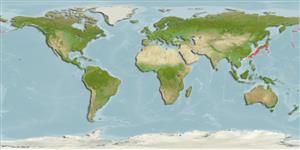Environment: milieu / climate zone / depth range / distribution range
Οικολογία
Θαλασσινό(ά) βαθύβιο(ς); εύρος βάθους 792 - 1200 m (Ref. 28494). Deep-water
Northwest Pacific: central and southern Japan and Nintoku Seamount. Recently recorded from Taiwan (Ref. 54421).
Μέγεθος / Βάρος / Age
Maturity: Lm ? range ? - ? cm
Max length : 63.5 cm TL αρσενικό/απροσδιόριστο; (Ref. 54421)
Short description
Κλείδες προσδιορισμού | Μορφολογία | Μορφομετρία
Head very wide and rather elongate. Bones of head soft and cavernous. Orbit small. Mouth terminal and oblique. Teeth minute, roughly equal, with arrow-shaped tip, set in broad band on premaxillary and in narrow band on dentary. No teeth on vomer or palatine. No barbel. Scales cycloid, small, and deciduous. Scales on mandibular ramus comparatively large, arranged in a single row (Ref. 54421).
Life cycle and mating behavior
Γεννητική Ωρίμανση | Αναπαραγωγή | Γεννοβολία | Αβγά | Γονιμότητα | Προνύμφες
Masuda, H., K. Amaoka, C. Araga, T. Uyeno and T. Yoshino, 1984. The fishes of the Japanese Archipelago. Vol. 1. Tokai University Press, Tokyo, Japan. 437 p. (text). (Ref. 559)
IUCN Red List Status (Ref. 130435: Version 2024-1)
Threat to humans
Harmless
Human uses
Εργαλεία
Special reports
Download XML
Διαδικτυακές πηγές
Estimates based on models
Preferred temperature (Ref.
123201): 4 - 5, mean 4.6 °C (based on 14 cells).
Phylogenetic diversity index (Ref.
82804): PD
50 = 0.5001 [Uniqueness, from 0.5 = low to 2.0 = high].
Bayesian length-weight: a=0.00372 (0.00141 - 0.00976), b=3.11 (2.88 - 3.34), in cm total length, based on LWR estimates for this (Sub)family-body shape (Ref.
93245).
Τροφικό Επίπεδο (Ref.
69278): 3.2 ±0.3 se; based on size and trophs of closest relatives
Fishing Vulnerability (Ref.
59153): Moderate to high vulnerability (45 of 100).
